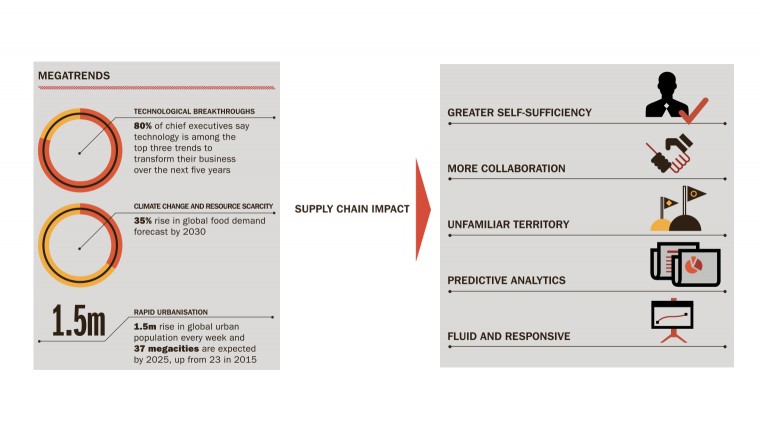The world is constantly changing and supply chain strategies must adapt to a new world order or face being ineffective and irrelevant. The supply chain innovations of yesteryear – barcodes, computerised tracking systems, the just-in-time delivery model and even online delivery channels – have all been responses to broader trends taking place at that particular time.
Today, we see five megatrends emerging that will continue to shape the business landscape over the coming decades, each having implications for how organisations will set up and run their supply chains:
- Shift in global economic power: By 2030, the size of the seven leading emerging economies will overtake that of the current G7 group.
- Demographic and social change: By 2025, the world’s population will have risen by one billion, taking the total to eight billion.
- Technological breakthroughs: Some 80 per cent of chief executives class technology as one of the top three trends that will transform their business over the next five years.
- Climate change and resource scarcity: As the world becomes more populous, urbanised and prosperous, demand for energy, food and water will rise. An increase of 35 per cent is expected in global food demand by 2030.
- Rapid urbanisation: The global urban population is growing by 1.5 million people every week and by 2025 it is expected that there will be 37 megacities, up from 23 today.
These megatrends will all collide to impact on supply chains, forcing business leaders and supply chain professionals to respond. “These trends will grow in importance and drive a radical change in how supply chains operate,” says Johnathon Marshall, UK supply chain lead at PwC. “Supply chain leaders must think about how the trends will impact their organisations and how they must respond to maintain long-term competitiveness.”
PwC contends that supply chains are likely to respond in a number of ways:
GREATER SELF-SUFFICIENCY
The continued rise of megacities means it won’t make economic sense to transport certain goods over long distances; a trend that will be compounded by the pressure to reduce carbon emissions and the consumer preference for rapid delivery of products. As a result, organisations will look to develop more localised supply chains, using local materials and labour to tailor products to local markets thereby driving down time to market and lead times. The development of self-sufficient supply chains will also help reduce supply continuity risk.
MORE COLLABORATION
The continuous shift in increased economic purchasing power towards new geographies and markets means organisations will move away from the traditional model of having their own costly manufacturing footprint in local markets.
Instead, the focus will be on collaborating with value-chain partners, making use of virtual manufacturing and plug-and-play factories. This will provide the necessary supply chain flexibility without the burden of high fixed costs.
Five megatrends will continue to shape the business landscape over the coming decades, each having implications for how organisations will set up and run their supply chains
“Instead of investing to set up new supply capacity, in the future organisations might be buying capacity in a local region for the short term to better service transient and volatile demand,” says Mr Marshall. “That might require partnering with either your peers or those in an adjacent industry to make sure you can satisfy the demand you have locally.”
PREDICTIVE ANALYTICS
The explosion of data being produced by people, companies and smart objects will allow organisations to gain deeper insight into trends and consumer behaviours. Combining data from disparate and unstructured sources, such as weather reports, social media output and home appliances, to draw meaningful patterns in consumer behaviour will allow supply chains to predict demand and identify stock shortages or delivery issues much earlier.
“An organisation could use artificial intelligence to predict a sudden surge in mobile phone volumes, determine stock levels and resolve any parts issues with suppliers before the problem even arises,” says Mr Marshall.
This reliance on rich and unstructured data, however, will require smarter integration between system platforms to provide genuine end-to-end visibility and insight of the entire supply chain. In turn, this will improve service levels, make supply chains more efficient and provide the capability to enable faster product development cycles while also minimising working capital.
UNFAMILIAR TERRITORY
The rising population and growing pressure on the Earth’s natural resources will see a rush to find raw materials located in less obvious places. This could include deep-ocean extraction through to asteroid-mining and interplanetary searches.
This has the potential to create huge challenges for the supply chain ecosystem, requiring new skills and technology platforms to manage complex networks and much higher levels of risk and uncertainty. Activities such as asteroid mining will present novel political and territorial challenges, including ownership disputes, with organisations needing to be able to react to changing circumstances in what is uncharted territory.
FLUID AND RESPONSIVE
Global variations of consumer purchasing power levels will lead to a greater demand for both customised and no-frills products.
Organisations are likely to require many supply chains: one, for example, for producing ultra-customised products meeting individual needs, while another for no-frills items focusing on speed and value. An automotive manufacturer could offer a standard value car readily available at a retail supermarket while also offering a car customised to individual needs which will have longer lead times and command a higher price.
Supply chains will need to be set up to meet demand from different consumer types and be able to switch seamlessly between their chains in response to changing requirements.
Organisations that align their business strategy with their supply chain strategy typically achieve stronger business performance resulting in an average of 20 per cent higher profitability.
Businesses need to analyse the megatrends to understand the implications on their supply chain – how are you shaping your future supply chain?
To discuss how PwC can help shape your future supply chain, visit http://www.pwc.co.uk/consulting/supply-chain-management.jhtml or call
+44 (0) 20 72131 1768

